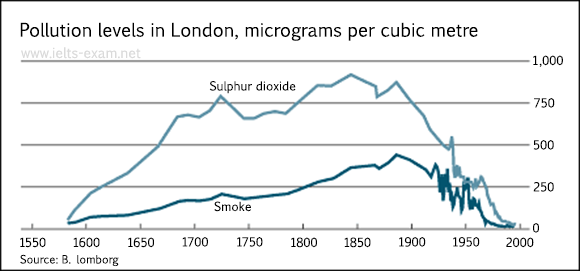IELTS Writing Task 1 #132
Test Tip
When you are describing a chart or graph, you
are actually describing the patterns he the data. Before you begin to write,
spend one or two minutes noticing the different features of the visual information.
To help identify the patterns, you need to look for the
• peaks (high points) and troughs (low points)
• periods when the figures remain steady (show little or no change)
• periods when the figures fluctuate (show a lot of changes)
You should spend about 20 minutes on this task.
The graph below shows the pollution levels in London between 1600 and 2000.
Summarise the information by selecting and reporting the main features, and make comparisons where relevant.
Write at least 150 words.

Model answer
(1st paragraph introduces the
topic of the graph, explains what the graph shows and outlines overall trends or
patterns.)
The graph shows pollution levels in London between 1600 and 2000. It measures smoke
and sulphur dioxide in micrograms per cubic metre. According to the information,
the levels of both pollutants formed a similar pattern during this period, but there
were always higher levels of sulphur dioxide than smoke in the atmosphere.
(2nd paragraph describes the trends
in more detail and illustrates these using data from the graph.)
In 1600, pollution levels were low, but over the next hundred years, the levels
of sulphur dioxide rose to 700 micrograms per cubic metre, while the levels of smoke
rose gradually to about 200 micrograms per cubic metre. Over the next two hundred
years the levels of sulphur dioxide continued to increase, although there was some
fluctuation in this trend. They reached a peak in 1850. Smoke levels increased a
little more sharply during this time and peaked in 1900 at about 500 micrograms.
During the 20th century, the levels of both pollutants fell dramatically, though
there was a great deal of fluctuation within this fall.
(Final paragraph draws a simple
conclusion from the data.)
Clearly air pollution was a bigger problem in London in the early 20th century than
it is now.
(176 words)